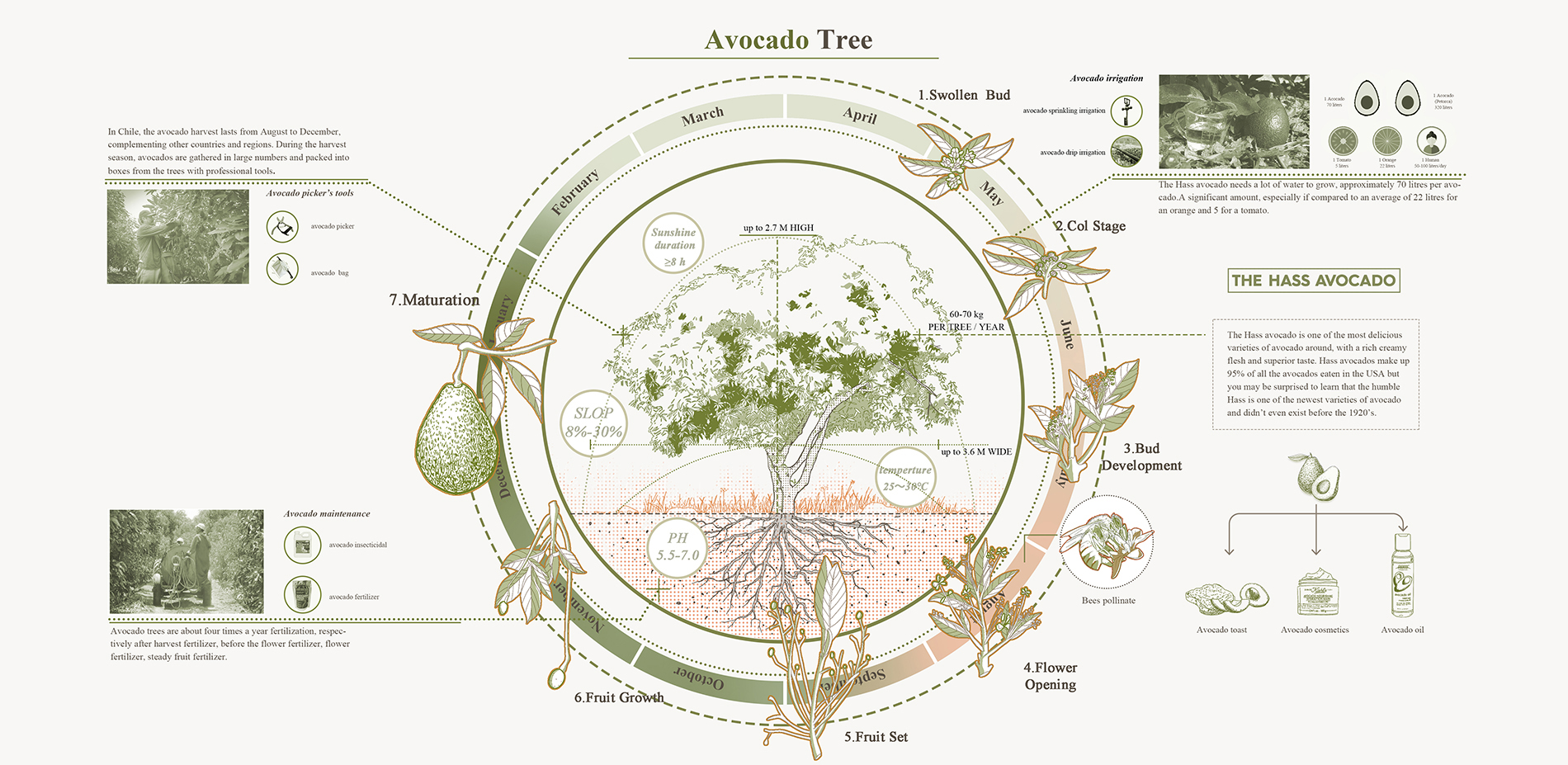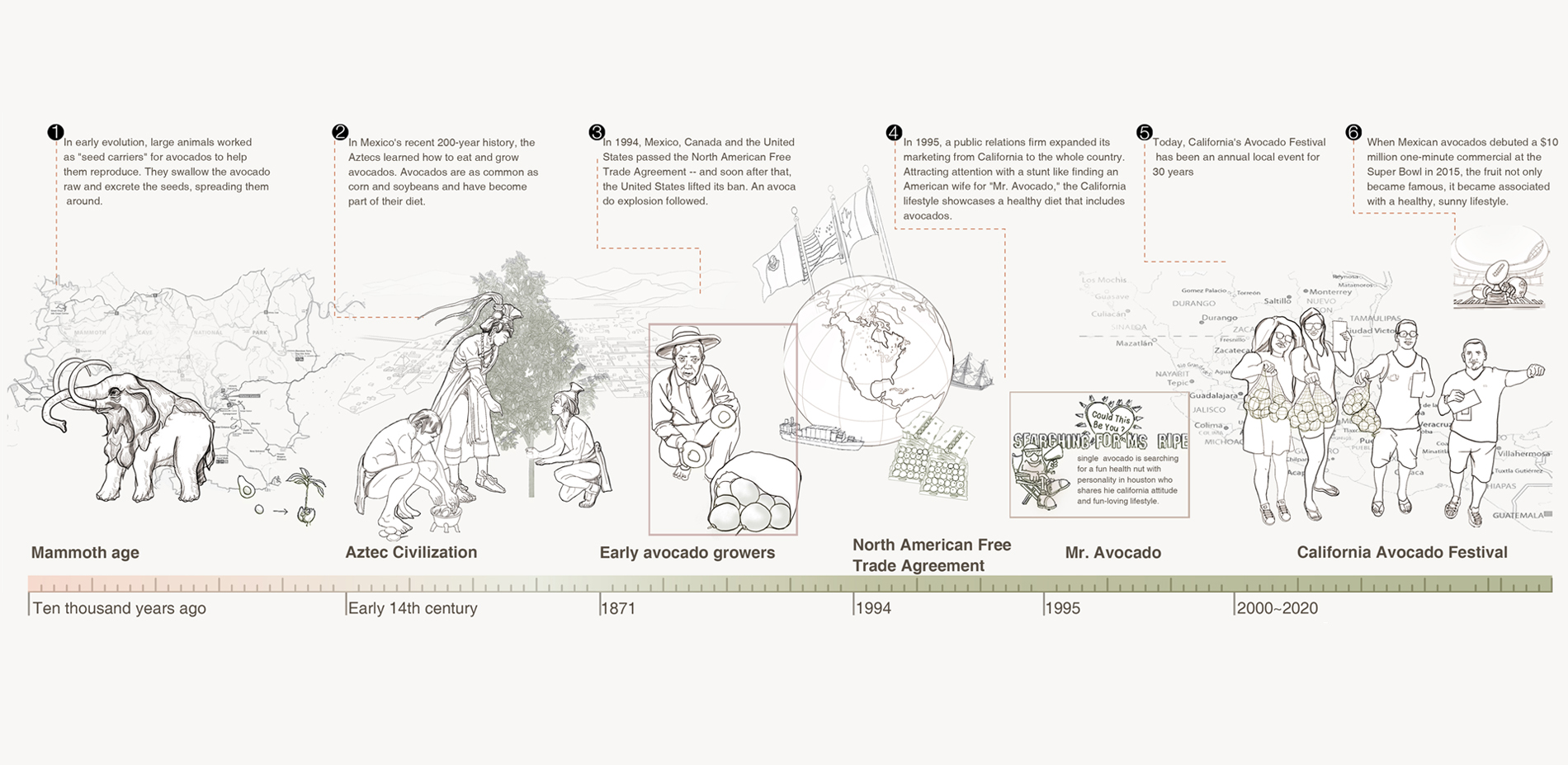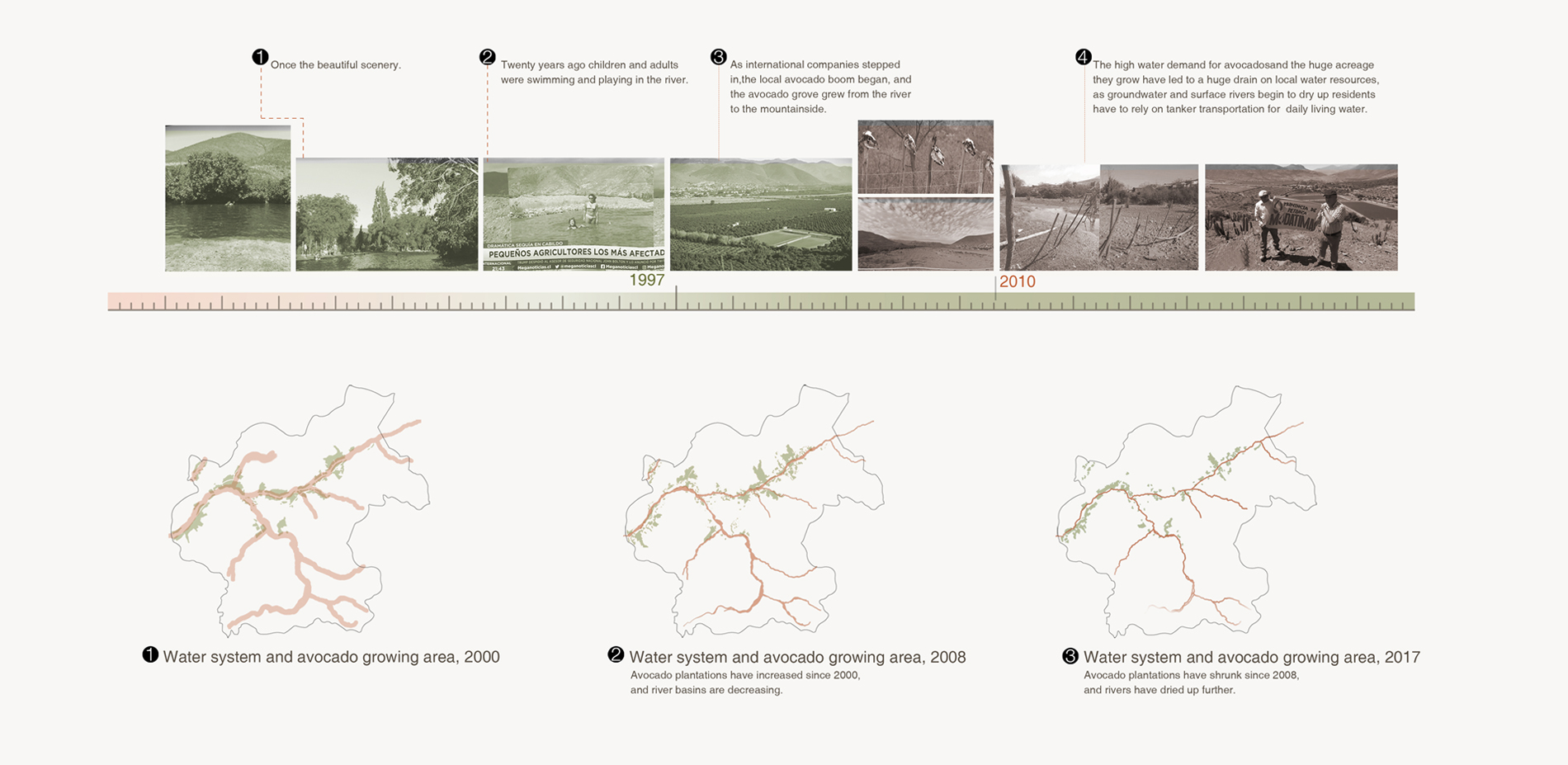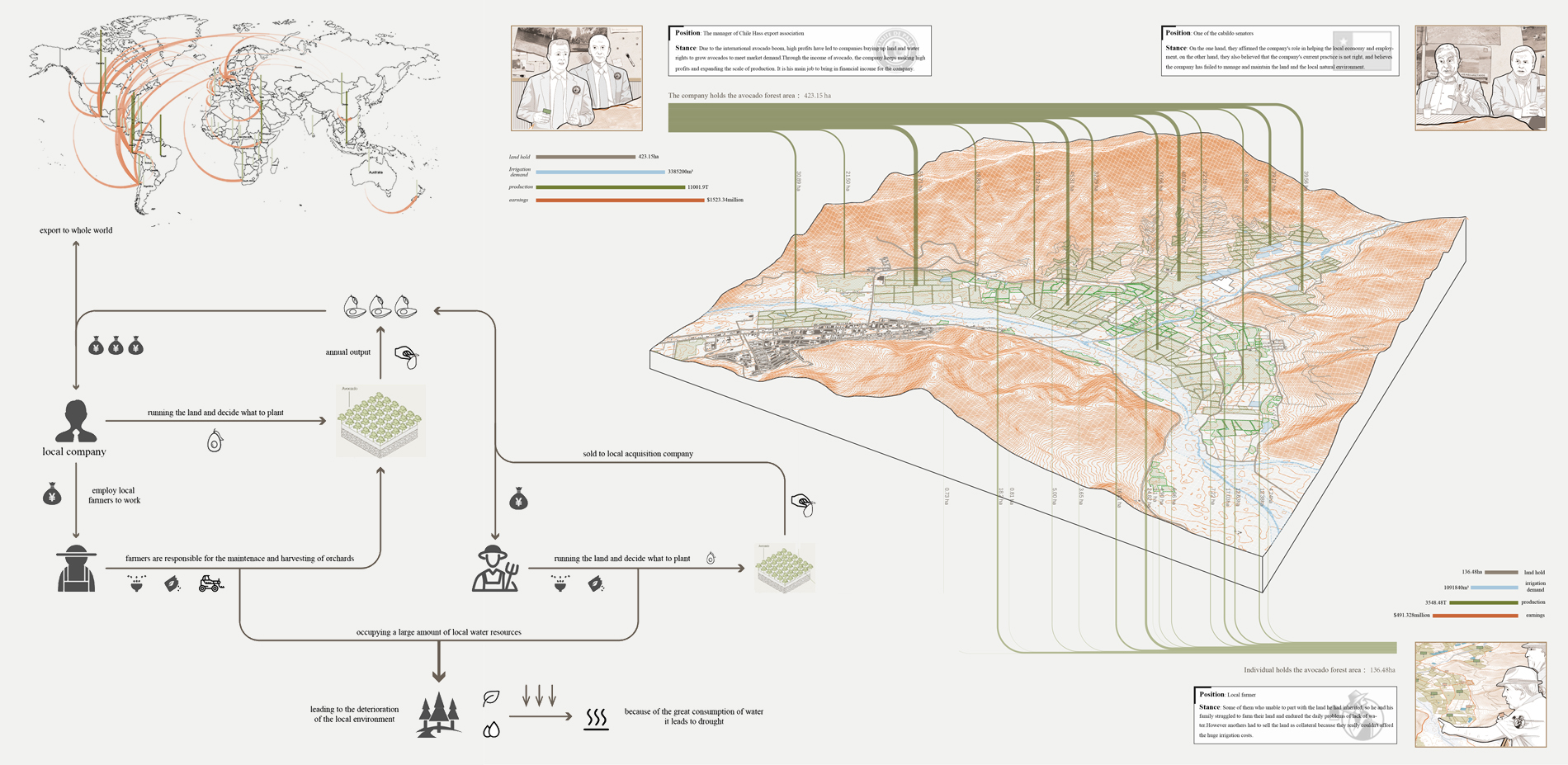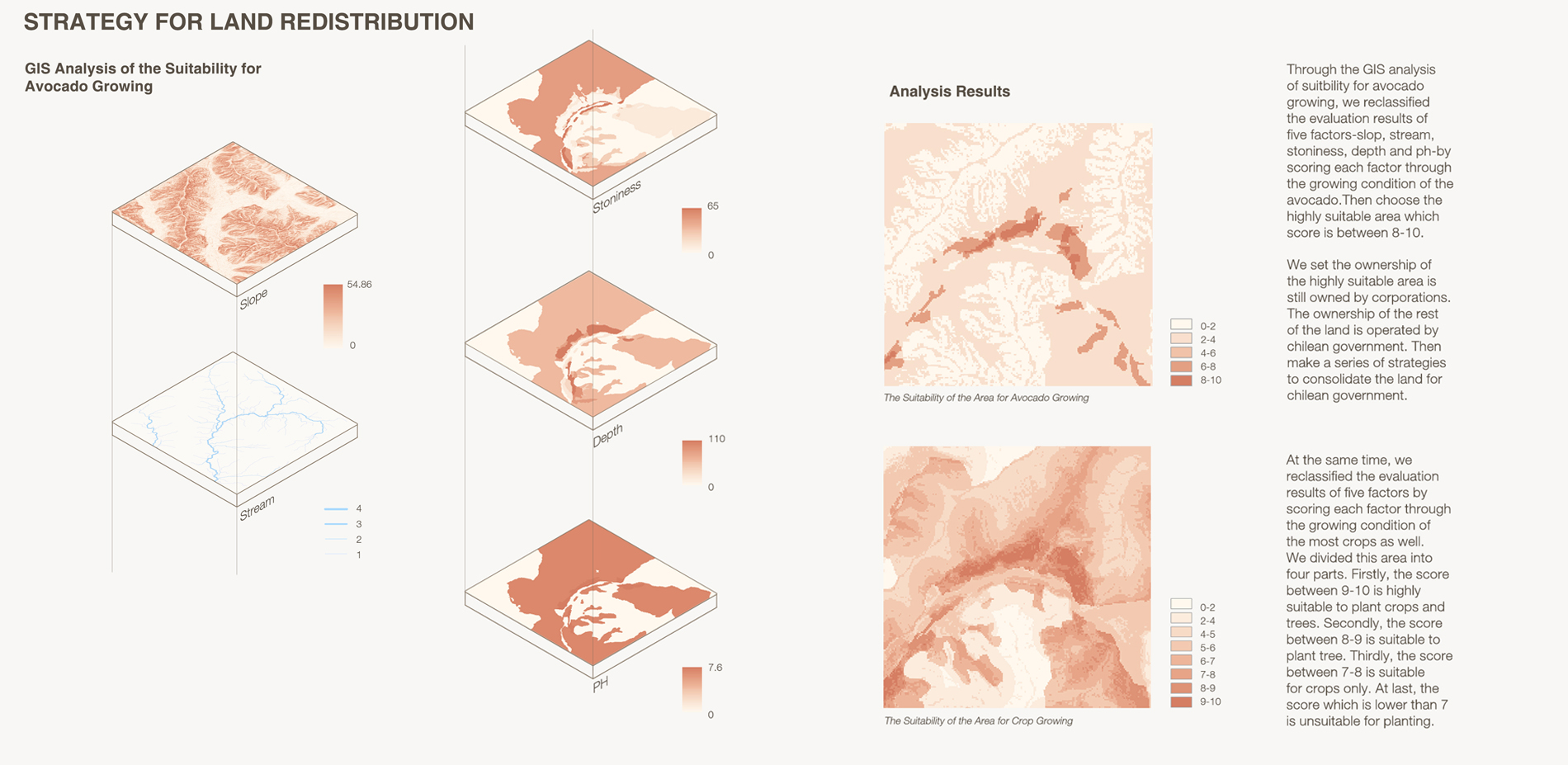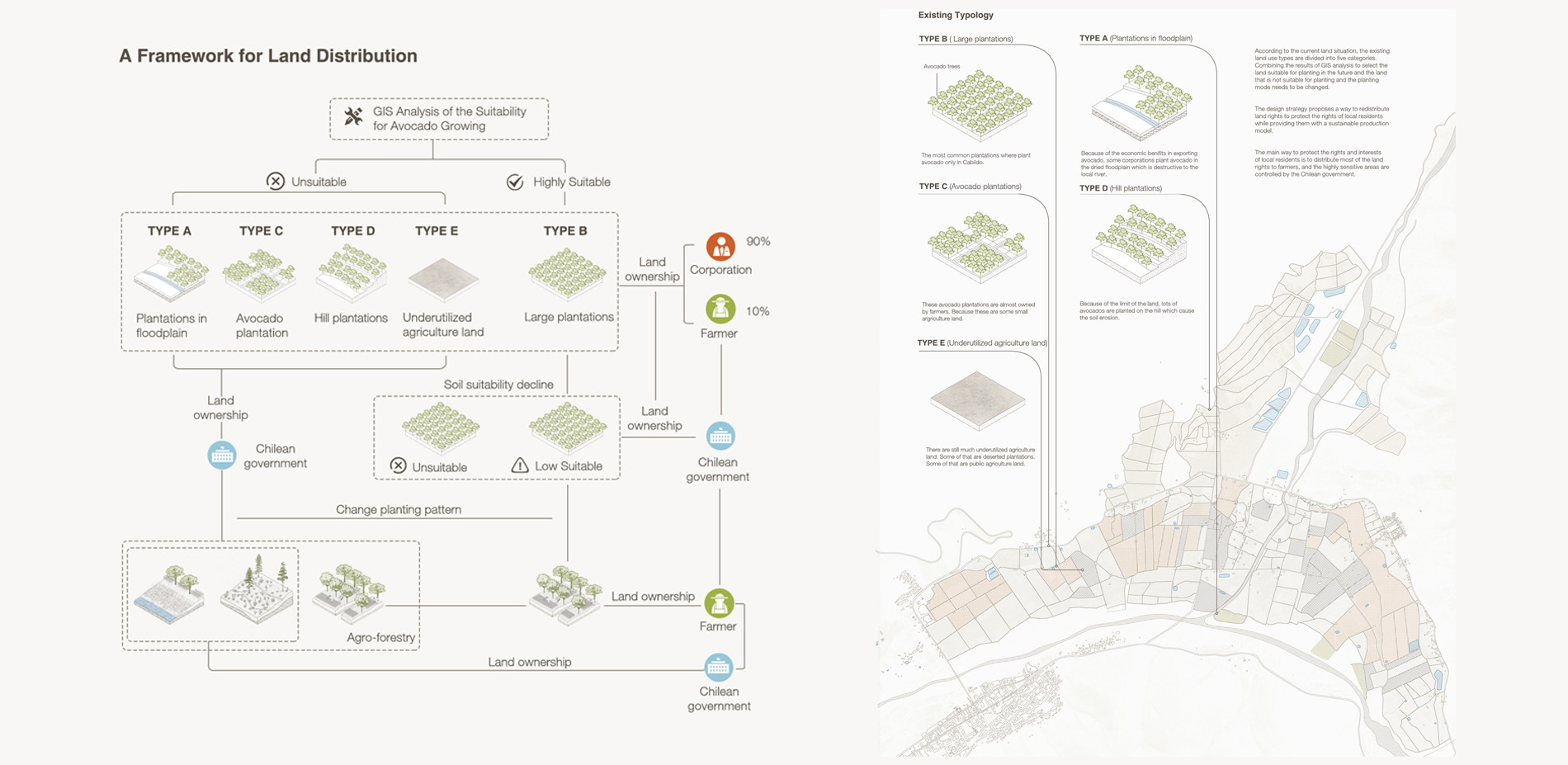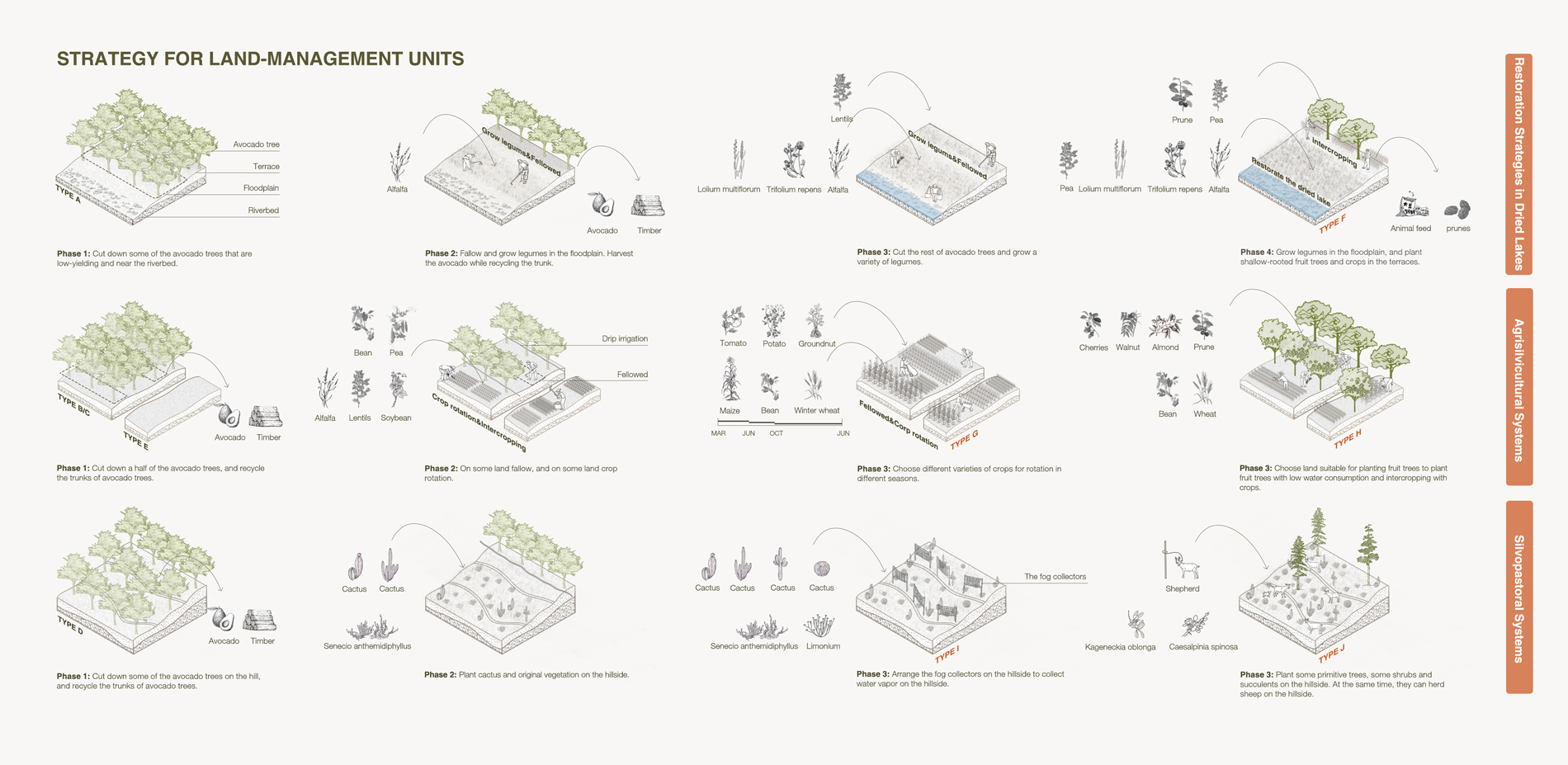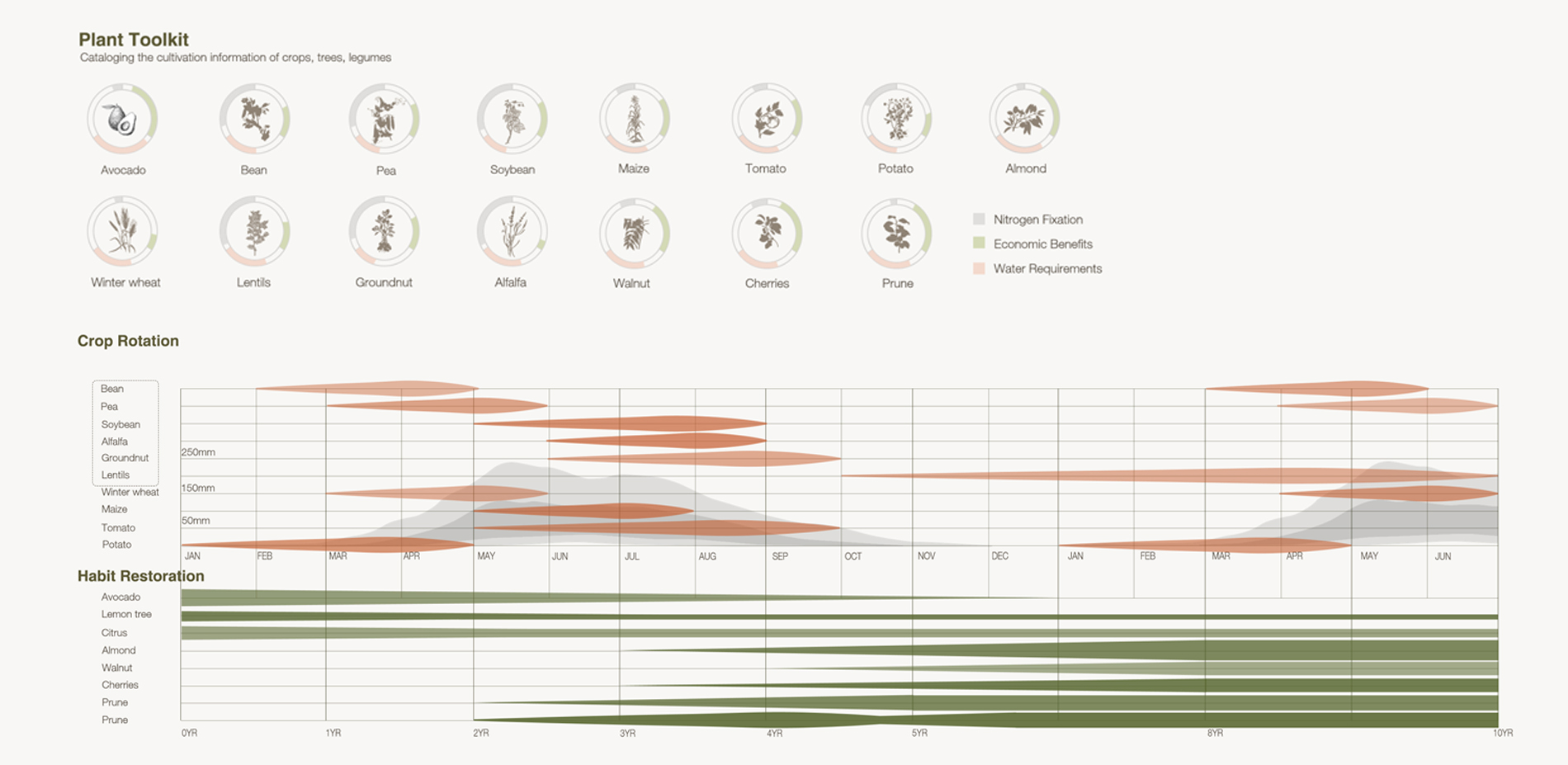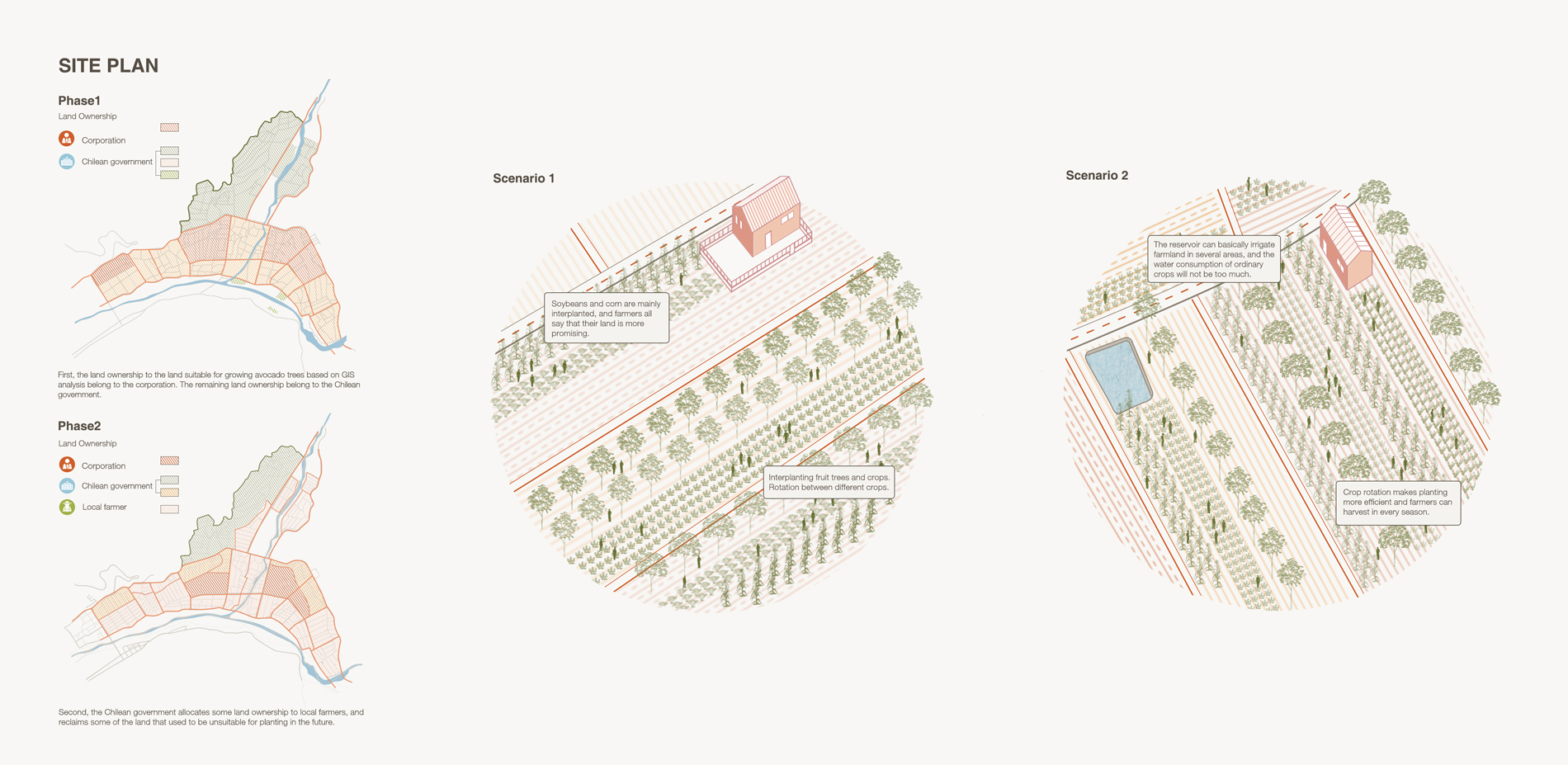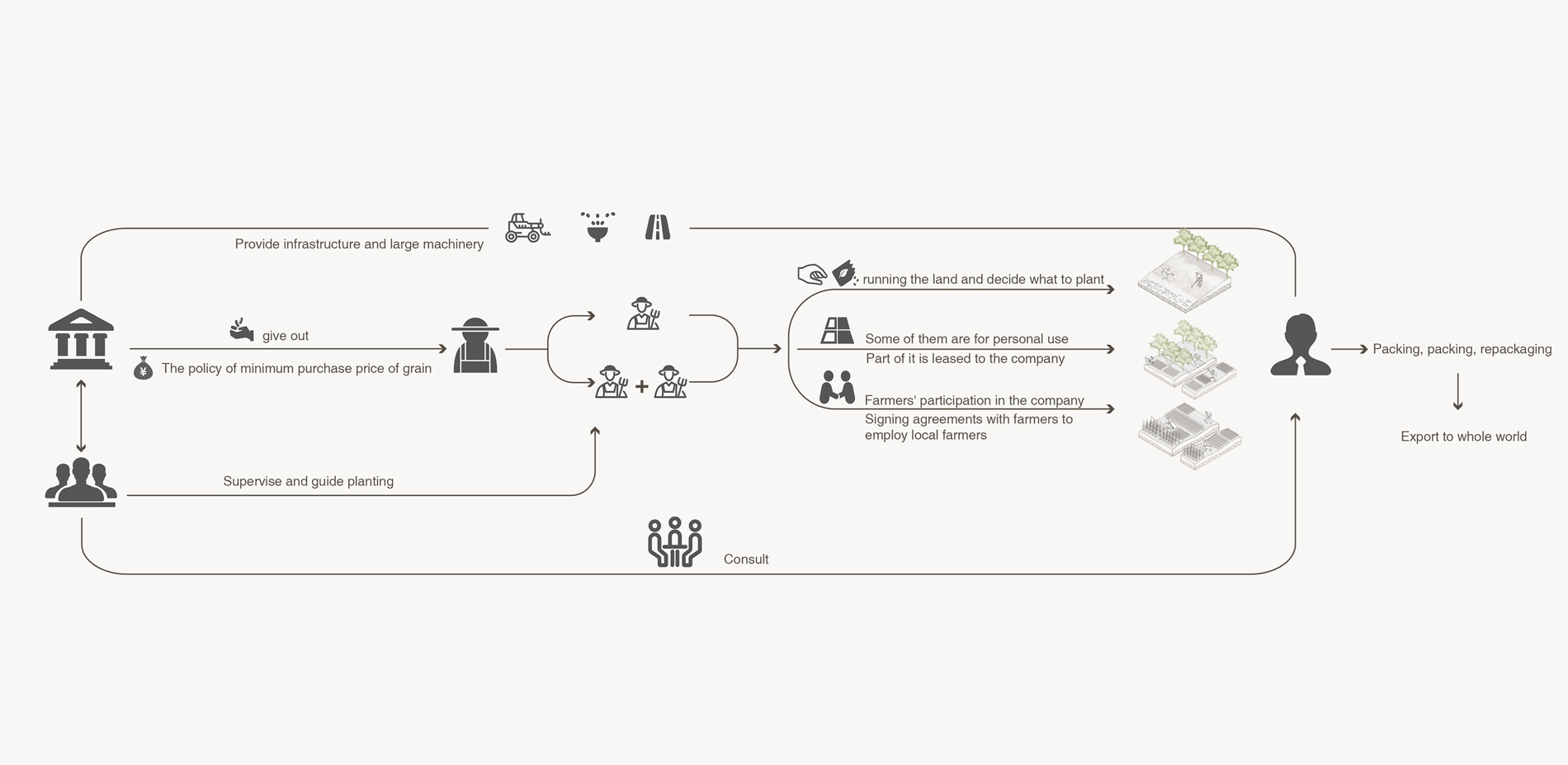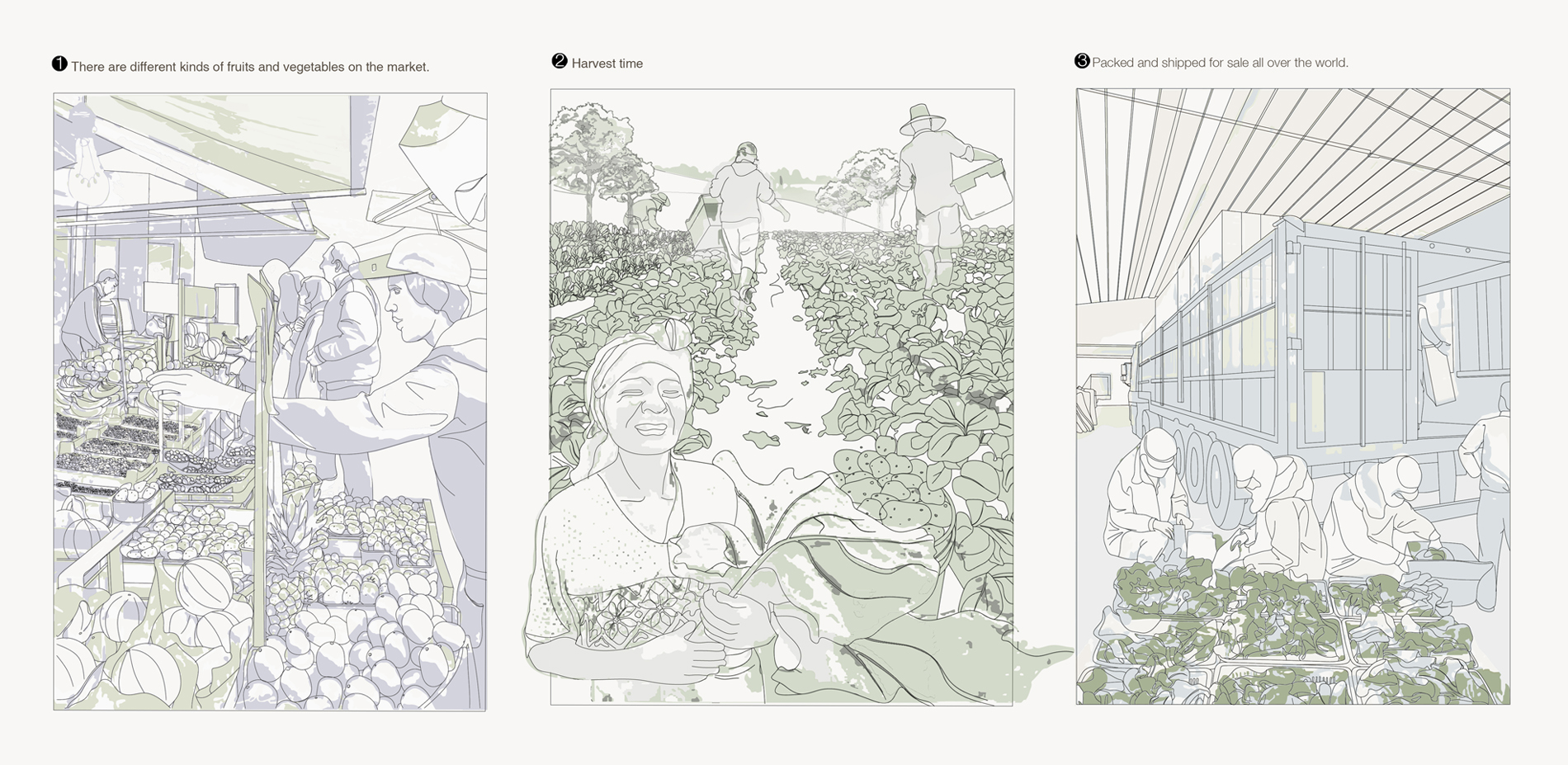Return of Land Rights: Land Restoration After Avocado Fever
Honor Award
Analysis and Planning
Cabildo, Chile
Junhui Zhang, Student ASLA; Hanyun Jiang; Yimiao Yao
Faculty Advisors: Xinqi Zhuang
Chongqing University
Chile is a major exporter of avocado and it has done a lot of damage to the land economically. We appreciated the way they laid out their data—it is beautiful and clear, and there's a good synthesis of the information of what this means for the economy and land within a timeline. There are also a lot of wonderful applications here in terms of studying the different technologies required for avocados to grow in specific microclimates.
- 2021 Awards Jury
Project Statement
Avocado trees consume a lot of water, and with the sharp increase of avocado exports, there is a conflict between water resources and deforestation. Since the large-scale planting of avocado, the water level of Petorca river began to drop. Until 1997, the Petorca river had basically dried up. In Cabildo County, there is a serious water shortage, because the proportion of avocado planting is as high as 97%. Because the privatization of land and water rights makes a lot of land and water resources occupied by foreign enterprises, so the proportion of local small farmers who plant avocado is less than 1 / 4. And the cultivation of avocado has brought great burden to the local residents' life and ecological environment.
The project aims to protect the rights of local residents and provide them with a sustainable production mode through the redistribution of land rights. The project is expected to not only improve the living conditions of local residents and create employment opportunities, but also restore the ecological environment.
Project Narrative
Background:
Due to the global upsurge and high profit of avocado, in Chile, where the planting conditions are superior, more and more land is used for the cultivation of avocado. It takes 2000 liters of water to produce one kilogram of avocado, which is four times that of oranges and ten times that of tomatoes. Because of the privatization of the land and water rights by the Chilean government, western companies has been involved in it, and land is used and sold as commodities to obtain the maximum profit in the short term. Land ownership means the right to use without doubt.
However, local residents are unable to fight with those big companies and cannot afford the high cost of buying water from other places. The plantation is gradually abandoned or swallowed by large enterprises due to water shortage. The domestic water is also not satisfied. More and more local residents are forced to move out of their land.
It has been until recently that with the increasing environmental damage, people have begun to realize the importance of ecological development and took relevant demonstrations and protests, demanding national legislation to protect the environment. Land ownership means not only the privilege of owning land, but also the responsibility for the public interest.
THESIS STATEMENT
The reduction of the avocado plantation is imminent. The project intends to gradually return the ownership of the land to the local farmers through government intervention, so that the local residents, rather than the capitalists, should become the users and guardians of the land. On the other hand, the avocado plantation will be gradually replaced by new varieties of crops with low water consumption, so as to improve the local soil and water shortage. Moreover, it brings new opportunities for local industrial transformation and makes the originally fragile single industry diversified.
Land right distribution strategy
The project first evaluates the suitability of planting avocado and other crops through the soil conditions (depth, pH, gravel content), precipitation and terrain slope, and then classifies the land according to whether the original land is planted with avocado.
Redistribution of land rights: 1. The land with high ecological sensitivity, such as slope land and riverside land, will be gradually transformed from plantation to woodland, which will be managed and maintained by the local government. 2. For the land that is not suitable for planting avocado, the national policy should take back the land, and return the land to the local farmers according to family distribution for soil restoration, and gradually transfer the ownership of the land to the farmers through 5-15 years of cultivation. 3. For the land suitable for planting avocado, the land right of the enterprise will remain unchanged, and whether to take back the land will be considered after annual suitability test.
It is hoped that through such a way of redistribution of land rights, this piece of land can escape the fate of being drained of its land value by capital. Let the people who live on this land for generations become the real owners of the land, because their destiny is closely related to this land, not the interests of those big companies.
Sustainable planting pattern
According to the existing five land types, there are three different development pattern.
Pattern 1: For the avocado forest near the river bed and beach, reduce the area year by year, harvest the avocado timber, increase the planting of leguminous plants year by year to repair the soil, and then add other economic crops with low water consumption such as almond and pea for rotation year by year. Finally, the purpose of restoring the riparian ecology is achieved.
Pattern 2: For the avocado forest planted on the flat land, the area will be reduced year by year, and the avocado timber will be harvested, and then the local low leguminous plants will be Interplanted on the land where the avocado trees are reduced. After the avocado forest is completely removed, different economic crops will be added in different seasons, such as tomatoes, potatoes, winter wheat, etc. Finally, we can choose to add some crops suitable for local cultivation, such as cherry, almond, walnut, pea, winter wheat and so on. Enrich the variety of crops.
Pattern 3: For the avocado forest planted on the mountain, the area will be reduced year by year, and the avocado timber will be harvested. At the same time, the local mountain plants will be planted on the hillside to increase the plant diversity on the hill. Then the fog water collection device is installed on the hillside to collect rainwater to supply the plantations at the foot of the mountain. Finally, local shrubs and trees are planted on the hillside to restore the mountain habitat, and grazing can also be carried out on the hillside.
Development of rural agriculture
According to the existing urban conditions, in the process of land right transfer, there are four different stages to improve the agriculture in this area.
1. Road planning
In the process of land integration, the road system will be re planned to improve the efficiency of transportation, and the land will be re divided to facilitate distribution.
2. Residential community
Improve the infrastructure of local residents, provide better living experience, technical support and training plan for local farmers
3. Rainwater collection system
Agricultural planting needs a large amount of water. For agricultural production, reservoirs and mountain fog water collection devices should be established to collect, store and transport water resources. At the same time, the collected rainwater can be used by local residents after purification and filtration.
4. Planning of planting equipment location
Crop planting and picking need to use a variety of agricultural machinery to improve the yield. Reasonable spatial layout can improve the use efficiency of planting and picking facilities, form an agricultural production system covering the whole field, and reduce the cost of repeated construction.
Plant List:
- Avocado
- Bean
- Pea
- Soybean
- Winter wheat
- Lentils
- Groundnut
- Alfalfa
- Maize
- Tomato
- Potato
- Almond
- Walnut
- Cherries
- Prune
